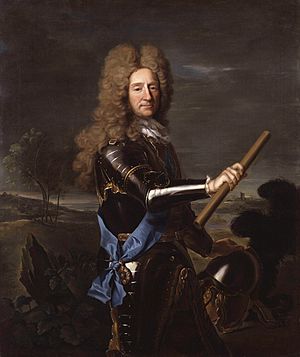William Bentinck, 1st Earl of Portland facts for kids
Quick facts for kids
The Earl of Portland
|
|
|---|---|

Portrait by Hyacinthe Rigaud, c. 1698-99
|
|
| English Ambassador to France | |
| In office 1697–1698 |
|
| Preceded by | The Lord Waldegrave |
| Succeeded by | The Earl of Jersey |
| Personal details | |
| Born | 20 July 1649 Diepenheim, Overijssel, Dutch Republic |
| Died | 23 November 1709 (aged 60) Bulstrode Park, Buckinghamshire, Kingdom of England |
| Nationality | Dutch and English |
| Spouses | Anne Villiers Jane Martha Temple |
| Parents | Bernard, Baron Bentinck Anna van Bloemendaal |
| Residence | Bulstrode Park |
William Bentinck, 1st Earl of Portland (born Hans Willem Bentinck in Dutch; July 20, 1649 – November 23, 1709) was a Dutch-born nobleman who became a close friend and trusted advisor to William, Prince of Orange. William later became the King of England. Bentinck was known for being steady, sensible, and modest. Their strong friendship and working relationship lasted for many years.
Contents
William Bentinck's Life
Early Years and Friendship with Prince William
Hans Willem Bentinck was born in Diepenheim, a town in the Dutch Republic. His family was old and noble. He started working for Prince William as a page and later became his chamberlain.
In 1675, Prince William became very ill with smallpox. His doctors suggested that someone healthy should sleep near him to help him recover. Bentinck volunteered for this and took great care of the Prince. This act of devotion created a very special and lasting friendship between them. From then on, Bentinck had the Prince's full trust, and they were very open with each other in their letters.
Helping Prince William Become King
Bentinck often traveled to England to help Prince William with important matters. In 1677, he went to ask for the hand of Mary, who was the daughter of James, Duke of York. Mary later became Queen of England.
In 1688, Prince William was planning to go to England to help remove King James from power. This event is known as the Glorious Revolution. Bentinck played a key role in preparing for this. He visited German princes to get their support or make sure they stayed neutral. He also helped organize everything for the invasion, including raising money and getting a large fleet of ships ready. Bentinck sailed to England with Prince William.
New Titles and Military Role
After the revolution, William became King of England. He rewarded Bentinck by making him a close advisor and a member of the Privy Council. In April 1689, Bentinck received several important titles: Baron Cirencester, Viscount Woodstock, and Earl of Portland.
He also served in the military. He led some cavalry soldiers at the Battle of the Boyne in 1690. He was also present at the Battle of Landen, where he was injured, and at the Siege of Namur in 1695.
Working as a Diplomat
Most of Bentinck's work was in diplomacy, which means dealing with other countries. In 1690, he went to The Hague to help King William solve a problem with the leaders of Amsterdam.
He helped arrange the Treaty of Ryswick in 1697, which brought peace to Europe. In 1698, he served as the English ambassador in Paris for six months. While there, he started talks with King Louis XIV of France about dividing the Spanish monarchy. He signed two important agreements, known as the partition treaties, on behalf of King William.
Resigning and Later Life
In 1699, William Bentinck became unhappy because another Dutchman, Arnold van Keppel, was gaining more influence with the King. Because of this, Bentinck resigned from his positions in the royal household. However, he did not lose the King's trust and continued to be asked for advice.
Bentinck received many gifts from the King, including a large amount of land in Ireland. This, along with the fact that he was a foreigner, made him somewhat unpopular in England. He continued to be involved in public matters under Queen Anne until he passed away at his home, Bulstrode Park in Buckinghamshire. His oldest son, Henry, became the next Earl of Portland and later received the title of Duke of Portland.
Codex Bentingiana
When Bentinck lived in the Netherlands, he had a special garden filled with many rare plants. Illustrations of these plants were collected in a work called Codex Bentingiana. This collection is no longer known to exist today.
William Bentinck's Family
Lord Portland was married two times.
His first wife was Anne Villiers. They married on February 1, 1678, and had seven children:
- Lady Mary Bentinck (1679–1726), who married the 2nd Earl of Essex.
- Willem Bentinck (1681–1688)
- Henry Bentinck, 1st Duke of Portland (1682–1726)
- Lady Anna Margaretha Bentinck (1683–1763)
- Lady Frances Wilhelmina Bentinck (1684–1712), who married the 4th Baron Byron.
- Lady Eleonora Sophia Bentinck (born 1687)
- Lady Isabella Bentinck (1688–1728), who married the 1st Duke of Kingston-upon-Hull.
His second wife was Jane Martha Temple. They married on May 12, 1700, and had six children:
- Lady Sophia Bentinck (1701–1741), who married the 1st Duke of Kent.
- Lady Elizabeth Adriana Bentinck (1703–1765)
- The Hon. William Bentinck, 1st Count Bentinck (1704–1774).
- Lady Harriet Bentinck (1705–1792)
- The Hon. Charles John Bentinck (1708–1779)
- Lady Barbara Bentinck (1709–1736), who married the 2nd Baron Godolphin.
In 1718, after William Bentinck's death, his second wife Jane became the Governess for the daughters of George Augustus, Prince of Wales (who later became King George II).

